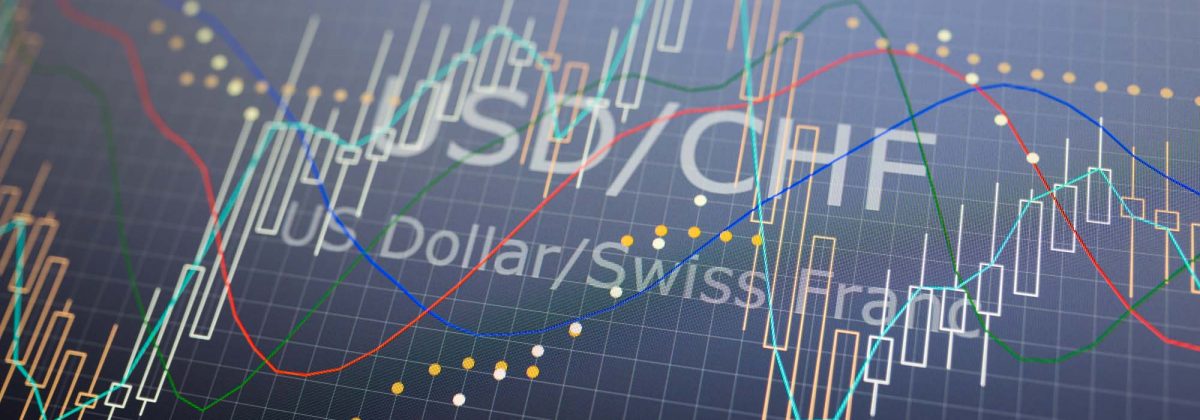The USD/CHF pair brings together two large world economies; the United States and Switzerland. It denotes how many Swiss Francs (quote currency) are needed to buy one US Dollar (base currency). Quite a popular trading pair, the USD/CHF accounts for about 4% of the total annual forex transactions, which places it in the fifth position on the list of most traded currency pairs in the world.
This popularity stems from the fact that the Swiss Franc is considered a very strong and stable currency, making it a safe haven asset for many investors. Given Switzerland’s politically neutral stance, during times of economic uncertainty, many investors prefer to park their funds in CHF, even if that means paying a higher interest rate.
For instance, on October 10, 2019, the USD/CHF gained 0.4% to trade at 0.9923, on account of widespread anxiety in the global markets associated with the faltering US-China trade talks. But on October 17, 2019, the pair was down 0.5%, with announcements of a new Brexit deal.
Factors that Affect the USD/CHF Pair
The US Dollar remains the most trusted currency in the world, but over the last 15 years, the Swiss Franc has gained value against the Greenback. Factors such as the European debt crisis and the United States’ accommodative monetary policies, have driven the strength of the Swiss Franc stronger. To trade the currency pair, it is important to understand the various forces that can affect the exchange rates.
Monetary Policy
A number of factors affect the US economy, with interest rate decisions by the US Federal Reserve being one of the key factors. The US Federal Open Market Committee (FOMC) meetings are held several times a year to decide on the interest rates, while the following press meetings give investors a general idea of where the US economy is headed.
The Swiss National Bank (SNB) sets a target for its desired interest rate (LIBOR). It has a huge influence on keeping the value of CHF stable. For instance, the central bank dropped its exchange rates to zero during the sub-prime crisis, to protect the national banking system. It also capped the value of the Franc against the Euro at 1.20, to maintain CHF’s safe haven status during the debt crisis.
However, in January 2015, this peg was suddenly removed by the SNB, causing a massive rally in the CHF (25% against the USD). This event occurred without any warning, leading to huge losses for traders.
To this day, the Swiss economy is grappling with the effects of such a strong currency, since it hurts exporters. In September 2019, the SNB left its interest rate unchanged at -0.75%, which is one of lowest rates in the world. There are reports that the central bank intends to take its interest rates further down, due to a potential global economic downturn. The US Federal Reserve is on a similar path. The stance taken by both banks will be crucial in the coming period.
Economic Indicators
One economic release that plays a huge role in determining the value of the US Dollar is the US Non-Farm Payroll report by the US Bureau of Labour Statistics, released on the first Friday of each month. Other reports to watch out for are the inflation data (CPI), retail sales data (Purchasing Manager Index), Department of Commerce’s monthly consumer spending reports and its quarterly outlook of any change in the US GDP rates.
Swiss inflation data (CPI), along with the KOF indicator, gives a view of the overall Swiss economic health. The KOF indicator is a leading composite indicator of the Swiss business cycle and is considered to be near accurate and reliable data.
A majority of the Eurozone and Switzerland economic data is released between 2:00 a.m. and 5:00 a.m. ET, and the USD/CHF shows significant volatility about 20 to 60 minutes prior to the release time. US economic data is usually released between 8:30 a.m. to 10:30 a.m. ET, tending to drive high trending movements in CHF crosses.
Geo-Political Uncertainty
High risk of war and conflict, or any negative news concerning the global economy can lead to the strengthening of the USD/CHF pair, due to the massive inflow of safe-haven money into Swiss banks. Switzerland is a small country but has a strong economic system, with a limited and realistic growth rate. It does not suffer from a trade deficit, which makes it self-reliant and stabilises its currency.
In fact, as of June 2019, it is the 6th largest creditor to the United States, with $232 billion worth of US treasury securities holdings. All these factors, along with an easy corporate tax structure, make Switzerland a prominent business destination, particularly in the sectors of banking and finance. This sustains the perception of the Swiss Franc being a reliable investment option.
Effect of Gold Price and Other Currency Pairs
The Swiss economy is considered prosperous and resilient against major economic crises, since the Swiss banking system has huge amounts of gold reserves. Almost 25% of Swiss Francs held in banks are backed by gold reserves. CHF has a negative correlation with gold prices. When gold price rises, the CHF weakens and vice versa.
Considering that a huge proportion of Switzerland’s trading activity occurs with EU nations, the value of the EUR also has a strong influence on the CHF. In fact, the SNB is more concerned regarding CHF’s value in relation to the EUR, than against the USD. It usually intervenes if the Swiss Franc becomes too weak or strong against the Euro, in order to protect Swiss export businesses, like it did in 2015.
So, the USD/CHF has a negative correlation with the EUR/USD. Typically, when the EUR/USD weakens, traders buy USD/CHF, which leads to a surge in its value. The EUR/CHF also has an influence on the USD/CHF, due to the positive correlation between the two pairs.
The USD/CHF usually shares a negative correlation with the USD/JPY and the USD/CAD.
Advantages and Disadvantages of Trading USD/CHF
Investors like the refuge value provided by the USD/CHF pair, which lends it high liquidity even in times of economic crisis. It is highly sensitivity to geo-political news, making it quite predictable. Also, the flow of information regarding both the economies, the US and Switzerland, is continuous. Economic data from both countries is available in abundance for traders to conduct sound fundamental analysis. This helps with stable price information.
However, volatility in the pair is considerably lower than that of the EUR/USD or GBP/USD, which means less frequent trading opportunities. In addition, the US Dollar is also considered a safe-haven currency, which can be confusing for traders, while deciding where to put their money and how the pair will behave. This is why, even for safe haven instruments, risk management strategies are a must.
Reference Links
Start Trading in 3 easy steps
1
Complete the Application Form
It takes just minutes for us to verify your identity and set up your account.
2
Download MT4 Platform
Download MT5 and trade via your desktop, mobile or tablet. No minimum deposit required.
3
Start Trading
Trade more than 60 products (Forex, CFDs & Commodities)





